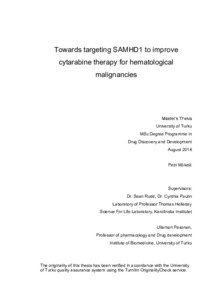Towards targeting SAMHD1 to improve cytarabine therapy for hematological malignancies
Mäkelä, Petri (2018-09-26)
Towards targeting SAMHD1 to improve cytarabine therapy for hematological malignancies
Mäkelä, Petri
(26.09.2018)
Julkaisu on tekijänoikeussäännösten alainen. Teosta voi lukea ja tulostaa henkilökohtaista käyttöä varten. Käyttö kaupallisiin tarkoituksiin on kielletty.
avoin
Julkaisun pysyvä osoite on:
https://urn.fi/URN:NBN:fi-fe2018122151592
https://urn.fi/URN:NBN:fi-fe2018122151592
Tiivistelmä
Acute myeloid leukemia (AML) is a hematological cancer where myeloid stem cells are transformed into malignant cells, filling and replacing the cells in a healthy bone marrow. Cytarabine is a nucleoside analog used in chemotherapy for hematological malignancies, such as AML, where it is combined with an anthracycline as a standard treatment. Nevertheless, this nucleoside analog in itself is not an active cytotoxic compound. Cytarabine is a prodrug that needs metabolism to become its active triphosphate form, which disturbs DNA synthesis and therefore is effective against rapidly dividing cancer cells. However, despite treatment, this leukemia might relapse, when treatment responses are usually less effective. SAMHD1 (SAM and HD domain containing protein 1) has enzymatic activity that could explain why cytarabine treatment is not effective in some patient populations. SAMHD1 displays enzymatic activity against the active cytarabine metabolite, converting this active triphosphate (Ara-CTP) back to its inactive form (Ara-C), similarly to deoxynucleoside triphosphates (dNTPs) that are converted to their corresponding nucleoside core along with inorganic triphosphates.
Recent studies indicate that inhibition of SAMHD1 could potentiate the efficacy of cytarabine treatment. SAMHD1 protein abundance has connections to ara-C response in leukemia cells: ara-C cytotoxicity is enhanced in THP-1 SAMHD1 knock out (KO) cells in comparison to proficient cell line variant (THP-1 ctrl). In this thesis work, I optimized a cell-based drug-combination assay and used it to test and evaluate combination treatment of ara-C and candidate SAMHD1 inhibitor compounds in a panel of hematological cancer cell lines and indeed demonstrated that creating a SAMHD1 deficient phenotype with chemical compounds can potentiate cytarabine-induced cytotoxicity in SAMHD1 dependent manner.
Keywords: Acute myeloid leukemia (AML), cytarabine (Ara-C), SAMHD1, synergy, combination treatment, precision medicine
Recent studies indicate that inhibition of SAMHD1 could potentiate the efficacy of cytarabine treatment. SAMHD1 protein abundance has connections to ara-C response in leukemia cells: ara-C cytotoxicity is enhanced in THP-1 SAMHD1 knock out (KO) cells in comparison to proficient cell line variant (THP-1 ctrl). In this thesis work, I optimized a cell-based drug-combination assay and used it to test and evaluate combination treatment of ara-C and candidate SAMHD1 inhibitor compounds in a panel of hematological cancer cell lines and indeed demonstrated that creating a SAMHD1 deficient phenotype with chemical compounds can potentiate cytarabine-induced cytotoxicity in SAMHD1 dependent manner.
Keywords: Acute myeloid leukemia (AML), cytarabine (Ara-C), SAMHD1, synergy, combination treatment, precision medicine
